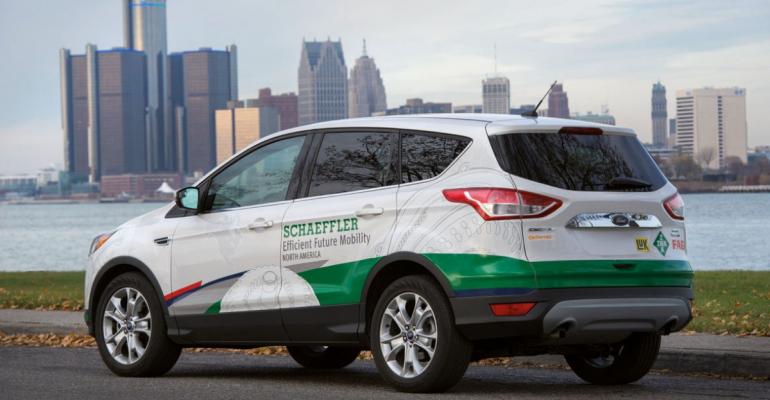DETROIT – Supplier Schaeffler is focusing on 48V drivetrain architecture for the electrified vehicles it says will account for nearly 10% of the global market by 2030.
The North American market is on the receiving end of much of Schaeffler’s work on 48V drivetrain architecture designed to facilitate low-speed electric driving, reduce emissions and boost fuel economy, Peter Gutzmer, chief technology officer, tells media this week at the North American International Auto Show here.
Schaeffler is testing the capabilities of 48V hybridization in concept vehicles including a Ford C-Max midsize SUV already compliant with the government’s 54.5 mpg (4.6 L/100 km) 2025 fuel-efficiency requirement.
The concept uses a transmission-driven accessory drive that functions as a parallel-hybrid system incorporating a selectable power flow between the transmission and the 48V MGU-equipped accessory chain. This eliminates the conventional belt drive and allows operation of accessories and energy recovery independent from the combustion engine. The accessory-drive system significantly reduces carbon-dioxide emissions, Schaeffler says.
Schaeffler also is developing a 48V concept vehicle based on an Audi TT. Based on an electrified rear axle that complements the front-wheel-drive engine, an additional belt-driven starter generator is connected to the engine, which also operates at 48V. The electric subsystem uses a lithium-ion battery connected to the 12V electric system, which powers various electrical components such as headlamps and seat adjusters.
“With the 48V concept car, we wanted to show that it is possible to produce a noticeable improvement in (fuel) consumption despite the very low voltage compared to standard hybrid vehicles,” Uwe Wagner, Schaeffler vice president-R&D automotive, says in a news release.
Also adopting 48V technology is an electromechanical active roll control that replaces the hydraulically controlled anti-roll bars now in general use, reducing fuel consumption and emissions and simplifies vehicle assembly. The system already is being used in a limousine and an SUV operating a 48V system.
Both 48V architectures and high-performance, high-performance-drive concepts utilize Schaeffler’s P2 high-voltage hybrid module slated for four customers when it goes into volume production in early 2017, Gutzmer says. It also has been integrated it into more than 70 prototypes and show cars, he says.
The module consists of an automated disconnect clutch that transmits traction torques from the engine to the transmission while transmitting torques toward the engine via the clutch. Torque range reaches 590 lb.-ft. (800 Nm). A variation on the module for the U.S. market is an integrated torque converter expected to be in use in a North American light-duty truck by 2020.





